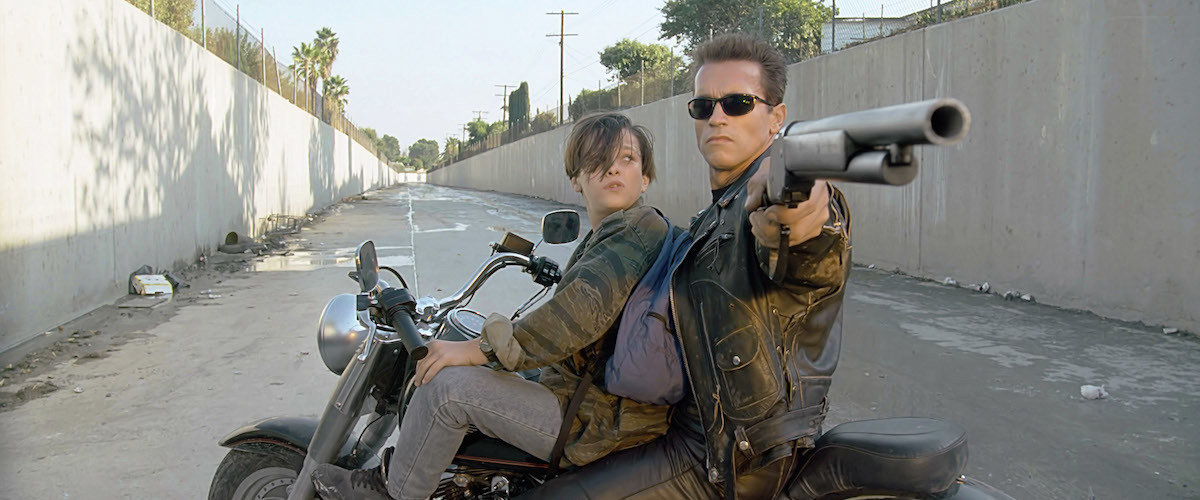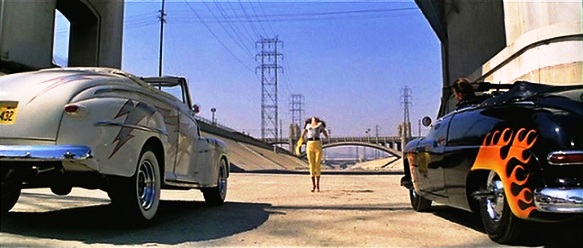Multiple films use the Los Angeles River and drainage system as both setting and integral plot device. Some of the most popular films highlighting this LA system connect this reconstructed river to science fiction creatures, which are also transformed, typically by a variety of human-caused eco-disasters. In Them! (1954), for example, giant queen ants mutated when they are exposed to atomic tests in New Mexico enter the L.A. drains to build nests for their enormous eggs. The juxtaposition of two types of transformed nature—concrete river drains and radiated ants—amplifies the film’s argument against exploiting the natural world.
In more recent science fiction films, the connection between the transformed natural environment of the L.A. River and some kind of monster merges with technology and the modern city. Both Transformers (2007) and In Time (2011) primarily use the river as a backdrop that accentuates the films’ sci fi themes. Terminator 2: Judgment Day (1991), however, highlights the environmental consequences and ultimate human costs of war. In Earth’s near future, ultimate cyborg weapons turn against their human creators. In a battle for the planet played out in the LA drains, two of these cyborgs travel back in time to either destroy or save John Connor (Edward Furlong), the future leader of the human resistance.
Most of the films that transform the Los Angeles River and drainage system, however, demonstrate that the environmental impact of this concrete-covered waterway has been treated as natural and desirable. Characters in a variety of films set in LA conform to this view of urban culture through their acceptance of environmental degradation in the form of both a transformation of natural and man-made landscapes. In these films, the LA River is transformed again for multiple uses. It becomes a racetrack for car chases and drag races in films as diverse as Grease (1978), Blue Thunder (1983), The Italian Job (2003), and Drive (2011). It serves as a gun range in films such as Point Blank (1967), Cleopatra Jones (1973), Gumball Rally (1976), Repo Man (1984), and Last Action Hero (1993). Most recently, the world franchise series Taken 3 (2014) is set in L.A., where the hero on the run from the police discovers the storm drain system underneath a suburban home’s garage and escapes undetected into its swirling waters.
The Neo-noir Chinatown (1974), on the other hand, uses the LA River and drainage system to showcase a water rights theme. In Chinatown murder, infidelity, and incest all become integrally connected with water as a commodity in 1930s Los Angeles, a context established by an FDR picture in the opening shot of the J.J (Jake) Gittes (Jack Nicholson) private investigator’s office. Jake is introduced to an infidelity case but discovers the perpetrator is Hollis Mulwray (Darrell Zwerling), the chief engineer of Los Angeles’s Water and Power. According to Water and Power, Los Angeles is on the edge of the desert. Without water, the valley would turn to dust, and the Alto Valley Dam will save it, but Mulwray opposes the dam because it is shoddy and ineffective and because he discovers his former partner Noah Cross (John Huston) is dumping water from the Los Angeles reservoir into the ocean to prove the need for the dam. Ultimately Mulwray is murdered by the very water he serves. “Los Angeles is dying of thirst,” says a sticker near Jake’s car, but, as one police officer explains, “Can you believe it? We're in the middle of a drought, and the water commissioner drowns. Only in L.A.”
Despite this plethora of films showcasing the L.A. River and drainage system, the underground infrastructure showcased in Chinatown seems to be ignored by most film critics studying film noir and the city. Instead, when critics examine what have been defined as noir films in relation to the city and its modern foundation, they highlight the spaces above this underground, especially in relation to cultural context rather than filmic history.
Underground rail systems also play a big part in film noir. Subways, like the underground sewer and water drainage systems in other films, are first constructed and then reconstructed to serve the needs of the films’ protagonists. In Pickup on South Street (1953 Sam Fuller), Murder by Contract (1958 Irving Lerner) and Dark City (1998 Alex Proyas), for example, a noir underworld becomes a literal underworld in scenes shot in a dark angled subway or sewer used primarily as a hiding place for protagonists and/or their enemies. In film, the underground serves as a cinematographic wonderland, an aesthetic as well as ecological space that serves both function and form for noir films from He Walked by Night to Chinatown.




